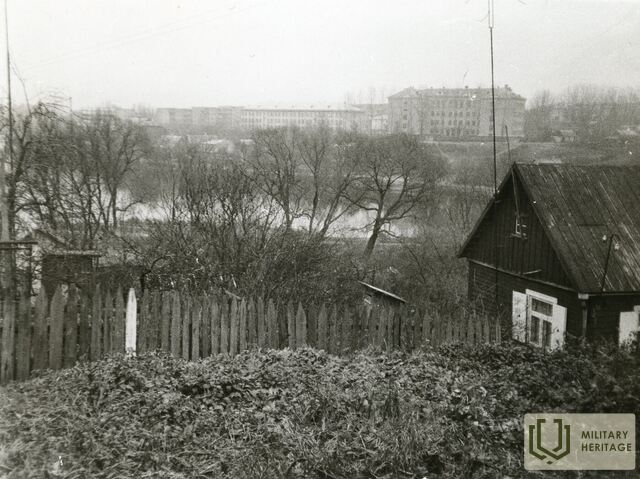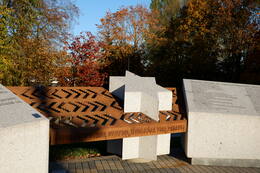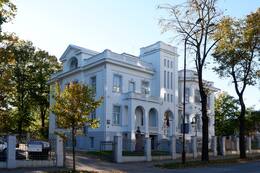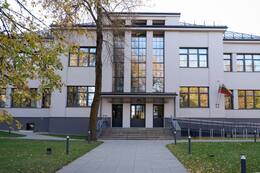Siauliai Ghetto II World War II
Before World War II, more than 8,500 Jews lived in Šiauliai. At the beginning of the Soviet-German war, about 1,000 of them managed to flee to the East, but about 14,000 Jews still remained in the city, including refugees from Poland, the Klaipėda region, and cities and towns in southern Lithuania.
After the German army occupied Šiauliai on June 26, 1941, various Nazi institutions were established in the city: the 819th Field Command, the secret field police, the 2nd operational unit of Operational Group A, the third company of the 65th German police battalion, and other units. The persecution and murder of Jews was led by SS Hauptscharführer Werner Gottschalk.
The first wave of repression lasted from June 27 to July 5, when more than 1,000 socially prominent Jews were arrested. The first mass killings took place on June 29 in the Luponia Forest near Kužiai, where several thousand people were killed during the summer. Later, massacres also took place near the village of Pročiūnai.
The occupation authorities introduced strict regulations that discriminated against Jews: they were forbidden to fly Lithuanian flags, own radios, and use the labor of people of other nationalities. From July 20, Jews were required to wear a yellow Star of David and could only walk the streets from 6 a.m. to 8 p.m.
The establishment of the ghetto was organized by the deputy mayor of Šiauliai city, Antanas Stankus. On August 15, 1941, 4-5 thousand Jews were housed in two ghettos: in the Kaukazo suburb and in the Trakų-Ežeros street area. The internal life of the ghettos was managed by the Jewish Council (Judenrat), headed by Mendel Leibavičius. The council took care of food, sanitation, labor distribution, and other daily matters.
In early September 1941, new mass killings took place near the village of Bubiai and in the Gubernija forest, where about 1,500 people were killed. After these killings, the ghetto was relatively calm until 1943. At the end of 1942, engineer Joselis Leibavičius founded a secret self-defense organization, which, although it accumulated weapons, did not carry out armed actions. The underground published secret newspapers "Masada", "Hatechija" and "Mimamakim".
The Wenclauskas family provided significant assistance to the ghetto residents, hiding Jewish children and establishing workshops for women. The Frenkel leather and shoe factory, where most prisoners worked, was particularly important for the survival of the ghetto.
In September 1943, the ghetto became a concentration camp under the SS. Sub-camps were established at the Zokniai airfield, the Linkaičiai arms workshop, the Paventiai sugar factory, and elsewhere. On November 5, 1943, a brutal "action" was carried out - 570 children and 260 elderly people were taken to the Auschwitz concentration camp.
As the front approached, the ghetto was finally liquidated in July 1944. In several stages, all prisoners were taken to the Stutthof concentration camp, from where the men were transferred to Dachau. In April-May 1945, the concentration camps were liberated by Allied troops. Out of more than 8,000 Šiauliai Jews, only 350-500 survived the Holocaust.
More information sources
Related timeline
Related objects
Square for the Righteous Among the Nations (Monument)
On 22 October 2021, the Square for the Righteous Among the Nations (monument) was inaugurated in Šiauliai, at the intersection of Ežero and Vilniaus streets. It is the first monument to the Righteous Among the Nations in Lithuania. The monument was created by the designer Adas Toleikis, a native of Šiauliai, and the idea of the monument was initiated by Sania Kerbelis, the chairman of the Jewish community of Šiauliai County.
The monument “Jungtis” is engraved with the surnames of the “Righteous Among the Nations” of Šiauliai County, thus commemorating 148 Jewish rescuers, while artistic accents mark the gates of the Šiauliai Ghetto. There were two ghettos in Šiauliai: in the so-called Kaukazo Quarter and in the Ežero-Trakų Street Quarter. Physically strong and able-bodied people were sent to the first one, and specialists (doctors, mechanics, etc.) to the second. The Šiauliai Ghetto was established in the summer of 1941 on the orders of the Šiauliai Commandant and liquidated in 1944 with the retreat of Nazi German troops. The remaining Jews were transferred to Stutthof and Dachau concentration camps. More than 5,950 Jews were imprisoned in the Ghettos. During the inter-war period, Šiauliai was home to about 6,500–8,000 Jews, some of whom left voluntarily into mainland Russia. After the Holocaust, there were only about 350–500 Jews left.
Venclauskiai House-Museum
The Venclauskiai House-Museum is an outstanding example of historical architecture from the inter-war period in Šiauliai. The building, also known as the White Castle, was built for the family of Kazimieras Venclauskas and Stanislava Venclauskienė in 1926 on the land of the former suburb of Šiauliai City. Kazimieras and Stanislava Venclauskiai – members of the Lithuanian national movement and the restoration of the Lithuanian state, are also famous as guardians of many orphans and abandoned children.
During the Second World War, Stanislava Venclauskienė and her daughters Danutė and Gražbylė became famous as rescuers of Jews. Ignoring the fact that, during the war, the German commandant’s office was stationed in their house, they helped the Jews imprisoned in the Šiauliai ghetto by hiding them in the house. Danutė Venclauskaitė had a permit to enter the Šiauliai ghetto, so she secretly brought food and medicine with her when she visited. All three women have been awarded the honorary title “Righteous Among the Nations” and the Life Saving Cross.
In 1991, Gražbylė and Danutė Venclauskaitės donated their family house to the Aušros Museum in Šiauliai. The Venclauskiai House-Museum was opened in 2019 after the reconstruction of the building. The permanent exhibition of the museum tells the story of the Venclauskiai family, while the semi-basement rooms are dedicated to the Holocaust and the rescue of the Jews.
Šiauliai History Museum
The Šiauliai History Museum is located on Aušros Avenue in central Šiauliai. After reconstruction, the museum opened its doors in 2022. It is housed in the historical Aušros Museum building, which was built in 1932 based on the design of a local architect, Vlad Bite. Originally it was a school building, while a part of the building was dedicated for the purposes of the museum in 1933. Today, the Šiauliai History Museum combines state-of-the-art technology with traditional exhibitions and a modern exhibition of museum funds. Here, visitors are introduced to the history of Šiauliai, from the earliest records about the area to the proclamation of the Republic of Lithuania in 1918.
Part of the exhibition is devoted to war themes. The first-floor hall features a restored short film that is based on historical documents about the Battle of the Sun that took place in the Šiauliai area; there are also exhibits (objects, documents, photos) related to World War I, which severely devastated the city, resulting in the loss of both inhabitants and infrastructure. The exhibition also displays evidence of the battles against the Bermontians, who invaded the town in 1919 and vandalised the houses. The content of the exhibitions of Šiauliai History Museum is expanded by knowledge rooms and an open-air exhibition. The museum also has an exhibition and event hall for multifunctional activities.
Related stories
Lithuanian rescuers - Miriam Javnaitė-Voronova's survival story
During World War II, Miriam Javnaitė-Voronova survived the Holocaust thanks to many Lithuanians who, risking their own lives and the lives of their loved ones, hid, fed, and cared for persecuted Jews.








